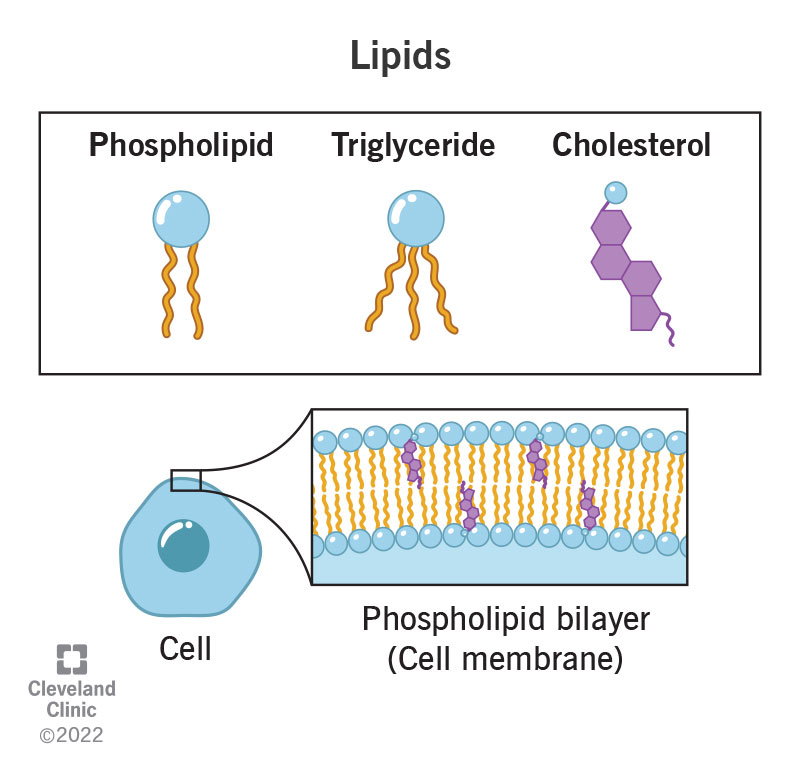Lipids are fatty compounds that perform a variety of functions in your body. They’re part of your cell membranes and help control what goes in and out of your cells. They help with moving and storing energy, absorbing vitamins and making hormones. Having too much of some lipids is harmful. A lipid panel can tell you if you have normal levels.
Advertisement
Cleveland Clinic is a non-profit academic medical center. Advertising on our site helps support our mission. We do not endorse non-Cleveland Clinic products or services. Policy

Lipids are chemical compounds (elements that make a chemical bond) in your body that help with some of its functions. These are fatty or waxy substances your body makes that don’t dissolve in water.
Advertisement
Cleveland Clinic is a non-profit academic medical center. Advertising on our site helps support our mission. We do not endorse non-Cleveland Clinic products or services. Policy
Cholesterol is a lipid in your blood. Your body needs it to help you take in fats and vitamins and make hormones. Cholesterol and triglycerides avoid water, so they can’t travel through blood themselves. This is why they combine with proteins to make lipoproteins that can move throughout your body.
You’ll recognize some lipids by their nicknames: HDL (high-density lipoproteins) and LDL (low-density lipoproteins).
Your liver and small intestine make HDL, which carries cholesterol into lipoproteins or your liver. Your liver converts it to bile acid so you can get rid of it. HDL (the “good” cholesterol) also fights inflammation, blood clots and oxidation.
Your liver makes VLDL (very low-density lipoproteins), which takes triglyceride from your liver to other cells. When VLDLs drop off triglycerides and cholesterol, they get denser and become LDL or the “bad” cholesterol. LDLs can stick to your artery walls and make it harder for blood to get through your arteries.
Various lipids have different functions. These include:
Advertisement
Lipids are in your blood and throughout your body. They’re in every cell you have.
Oxygen, carbon and hydrogen bond to each other to form lipids. Lipids like cholesterol are part of your cell membranes. They give your cells structure and allow substances to go in and out of your cells.
Your body can produce the amount of lipids it needs. However, sometimes, it produces the wrong amount of lipids. This can cause:
Most people with high lipid levels don’t have symptoms. However, very high cholesterol can show up as:
Your healthcare provider may order a lipid panel to measure the amount of cholesterol and triglycerides in your blood. To get the most accurate results, you’ll need to avoid eating anything (fast) for 12 hours before a provider takes a blood sample for the test. It’s easier to do this early in the morning because you don’t eat while you sleep.
For accurate results, don’t take this test when you’re sick or stressed. Also, avoid taking medicine that affects your lipid levels before the test. If you’re not sure whether any medications or supplements you take can affect the results, ask your provider.
A lipid panel or lipid profile tells a provider if you’re at risk for cardiovascular (heart and blood vessel) disease. Higher levels of total cholesterol (more than 200 milligrams per deciliter or mg/dL) and LDL (more than 130 mg/dL) mean you have a higher risk of heart disease. People with a history of coronary artery disease or stroke have more aggressive LDL targets because they have a higher risk of further cardiovascular disease.
Higher levels of HDL (60 mg/dL) are good because HDLs remove LDLs from your body.
If you have high levels of lipids that put you at risk for heart disease, your provider may prescribe cholesterol-lowering medication, such as:
To keep the bad lipids in your blood low or lower them if they’re too high, you can:
Lipids have important functions in your body’s cells, but having too much of some lipids can increase your risk of heart disease or cause other issues. Talk with your provider about your risk of heart and blood vessel diseases. They can tell you how often you should get a lipid panel to test your lipid levels. Also, they can help you get your numbers into a normal range.
Advertisement
Cleveland Clinic’s primary care providers offer lifelong medical care. From sinus infections and high blood pressure to preventive screening, we’re here for you.

Last reviewed on 11/03/2022.
Learn more about the Health Library and our editorial process.